Experts and the Quest for Dietary Culture
- TOP
- ESSAYS
- Experts and the Quest for Dietary Culture
- Feasting under the Cherry Blosssms (Spring)
Feasting under the Cherry Blosssms (Spring)
by Hayashi Ayano
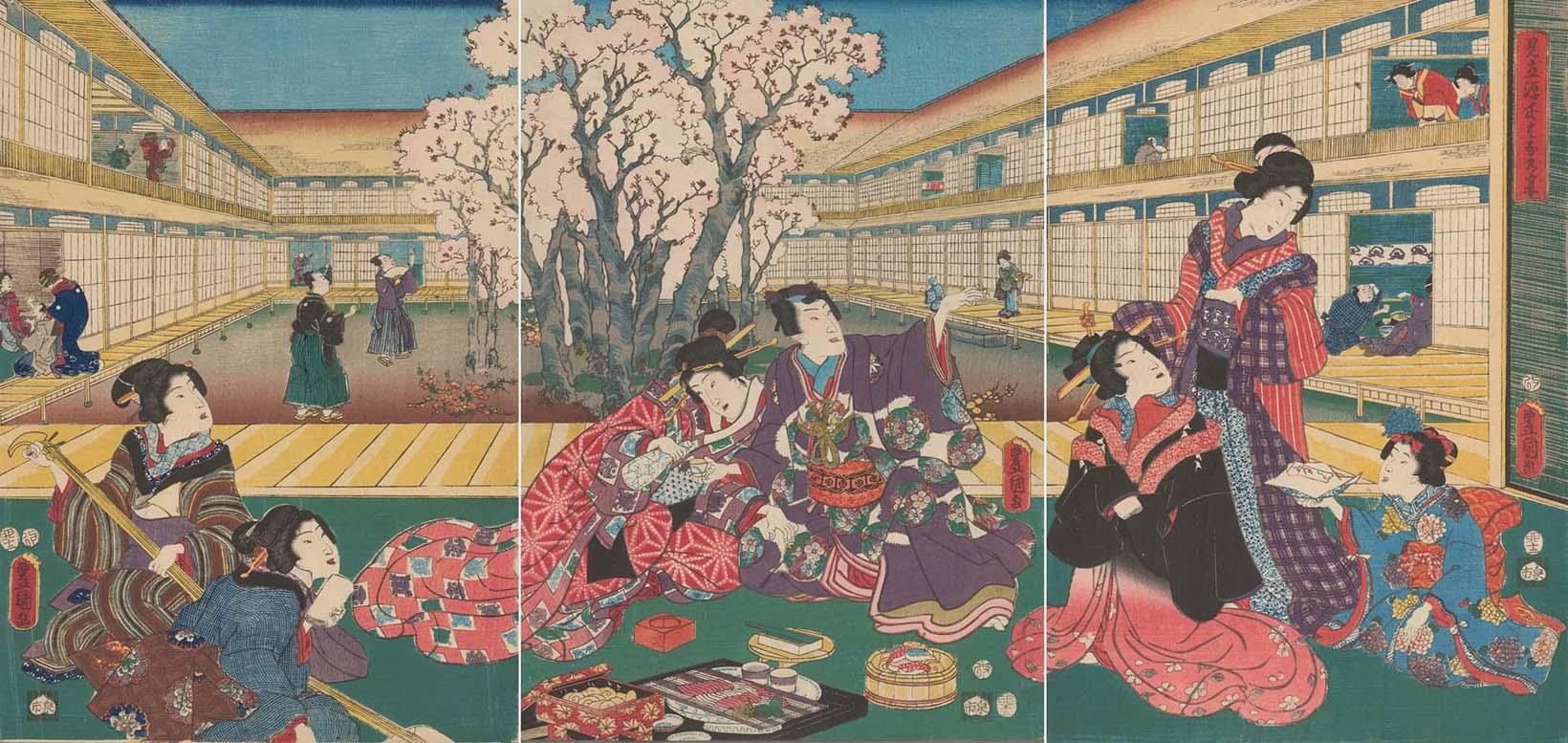
In front of the cherry blossoms there are people enjoying a feast. It's a mild and beautiful springtime scene that dates back to old times and hasn't changed much to this day. This triptych, titled Mitate Genji Flower Banquet by Utagawa Kunisada (1786-1865), was based on the long serialized illustrated novel Nise Murasaki Inaka Genji (An Imposter Murasaki and a Country Genji, 1829-1842) by the celebrated 19th century writer Ryūtei Tanehiko (1783-1842). The story of Nise Murasaki Inaka Genji was based on the Heian period (794-1185) classic Genji Monogatari (The Tale of Genji, early 11th century), but Tanehiko changed the setting of the medieval court to the world of the Muromachi period (1336-1573) samurai. After the first publication in 1829, Tanehiko's novel became a big hit in Edo. Kunisada was in charge of the images and drew most of the illustrations for the original Nise Murasaki inaka Genji books. He also published images like this triptych, which were published later but also became very popular.
The Food of a Lively Feast
In the center of this spectacular triptych, a dashing man and attractive woman dressed in kimonos in brilliant colors sit closely together. In front of them, various treats are stalled together, providing the scene with an impression of prosperity. On the left, in a pile of red maple leaf, there is date-maki (a rolled omelet mixed with whitefish), and on the large plate next to it, there is a white with purple mat. This kind of mat was used when people ate sashimi at the time. On top of it there is fish arranged in tsukuri-awase, a way of matching two kinds of food in different colors. The two kinds of fish carefully arranged here are probably tai (sea bream) and maguro (tuna). On the side of the mat there are also three ingredients to flavor the sashimi with: daikon-oroshi (grated Japanese radish), wasabi and siler. The black and yellow substance in the sake cups are probably boiled down sake and soya sauce for with the sashimi.
In the nearby bucket, nigiri-zushi (finger sushi) has been carefully arranged and piled together. On top there is shrimp, and the blue fish is probably kohada (gizzard shad). Inside, there is also a light-yellow piece of nigiri-zushi. Since a darker brown burned part can be seen, it might be anago (conger eel). On the bottom there is also maki-zushi (rolled sushi).
Nigiri-zushi was born in Edo. Since ancient times, pickled fish was fermented together with rice and referred to with terms like narezushi ('ripened sushi'), and sushi that was rooted in sushi recipes found in various regions in the country also existed. Among them, there was oshi-zushi (pressed sushi) found in the Kamigata (Kyoto and Osaka) region, which was pressed with a special tool and later spread to Edo as well. In the 18th century, seasoning ingredients like vinegar and soy sauce became widespread, and nigiri-zushi first appears. The combination of flavored fish with rice and vinegar gave the food a long life before it expired, and since it was easy to prepare, it became a much-loved dish among the people of Edo.
In the illustrated book Kane mouke hana no sakariba (Money-making Site of Blossoms) by the writer Jippensha Ikku (1765-1831), published in the 13th year of Bunsei (1830), an image of a sushi-selling yatai (street vendor) can be found. Nigiri-zushi in Edo started as street food. Together with the increasing popularity of the yatai, together with delivery, high-class sushi restaurants also appeared. This image probably depicts something being carried somewhere from a restaurants. Freely enjoying a feast in this way, was indispensable for the people of Edo. Sushi stacked up densely in this way looked pretty, and added color to the feast enjoyed below the cherry blossoms in full bloom.
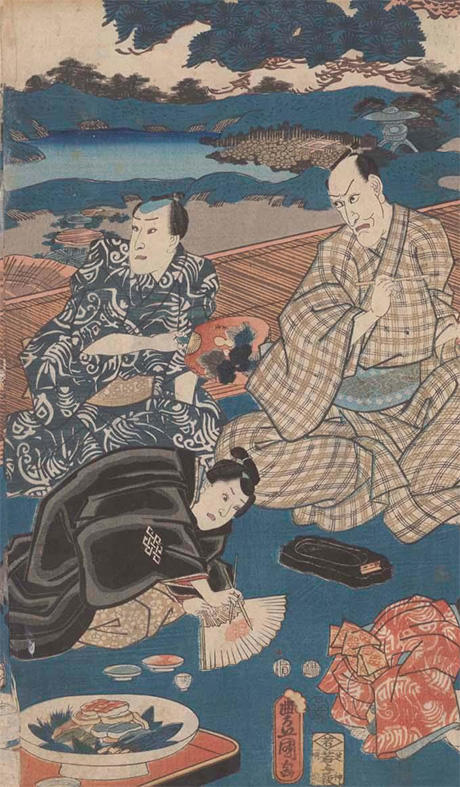
Ichikawa Ebizo V and his children amuse themselves by painting and writing on fans. The location is Kiba, Fukugawa in east Tokyo, the house where Ebizo lived. In this picture, sushi that was delivered to his home can be seen at the place where he and the children are gathering.
Sushi at home and in Restaurants
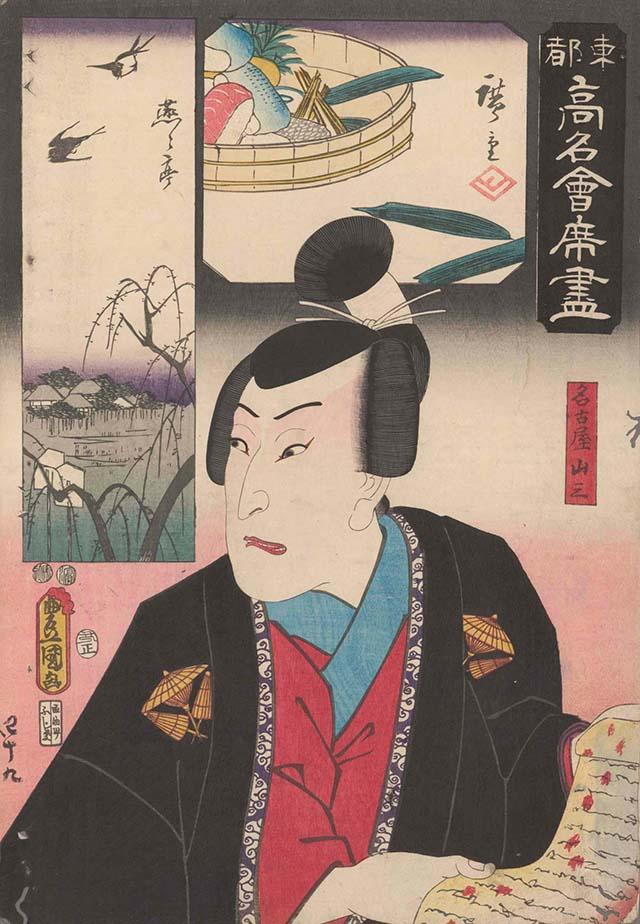
In the popular print series Famous restaurants of the Eastern Metropolis, which includes pictures of popular restaurants by Utagawa Hiroshige (1797-1858), with famous actors in front of them drawn by Utagawa Kunisada, sushi makes an appearance. The actor Sukedakaya Takasuke III (1802-1853), in the role of the Azuchi-Momoyama period (1573-1600) warrior Nagoya Sansaburō appears in front of a smaller picture of the sushi seller En'entei, which was located near the Yoshiwara licensed quarters. The sushi served there has also been depicted in the image next to En'entei.
Here too, the sushi was piled up in a bucket. This way of serving sushi was referred to as loading a bucket. The term temae probably referred to tai (sea bream), which can be identified by the skin. The blue piece is kohada (gizzard shad), the yellow piece egg, and the light red piece of maguro (tuna) sushi looks very realistic. On top of the bamboo grass these colors can be seen prepared together. With sushi cut this well and laid out in leaf this way, the atmosphere of the scene is very elegant.
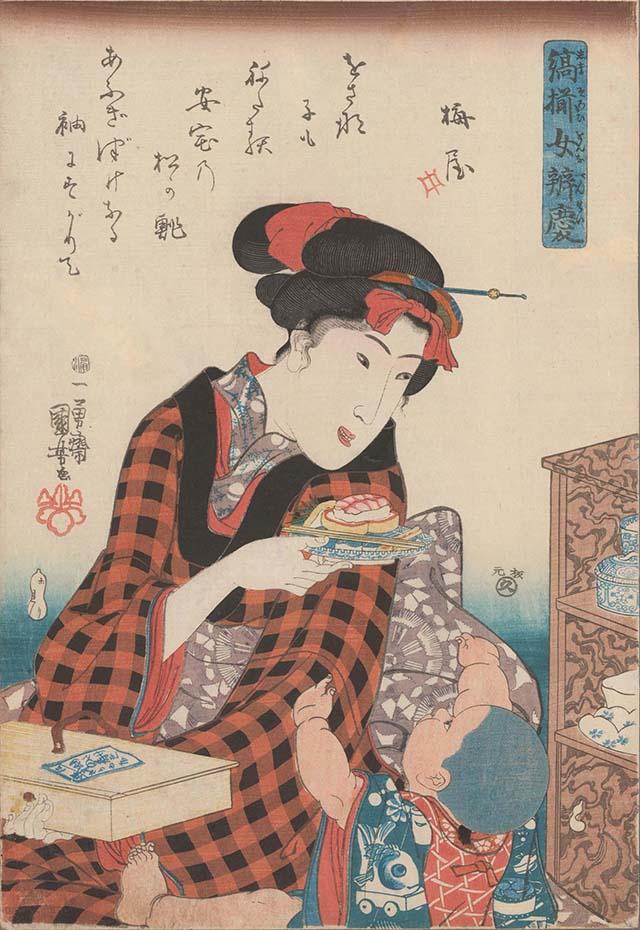
The Bakumatsu era (1800-1868) ukiyo-e artist Utagawa Kuniyoshi has also depicted a mother about to offer her eager child a plate of sushi. This image derives from the series Women in Plaid Related to Benkei, from1844. The poem inscribed above the image describes the image seen below the poem and mentions the name matsu-no-sushi (pine tree sushi). Matsu-no-sushi was a highly-valued shop that was said to have completely changed the way sushi was prepared. With eager arms raised towards the plate held by his mother, raising one foot, we can tell from this image that sushi was not only popular with adults, but children too. As food that could be brought home in lunch boxes, and given to other as a present, sushi was highly valued by the people of Edo.

The sushi drawn in ukiyo-e is piled on top of one another, and pressed sushi can be found at the bottom. At the time, it was normal to eat pressed sushi and nigiri-zushi (finger sushi) together. It also seems to have been common to eat sushi with toothpicks.
From food stands to high-class restaurants, sushi was widely consumed in Edo, but what kind of sushi existed at the time? The mid-19th century publication Morisada Mankō (Sketches by Morisada), which explains about life and customs in the Edo period, includes quite a few elaborate sections on sushi.
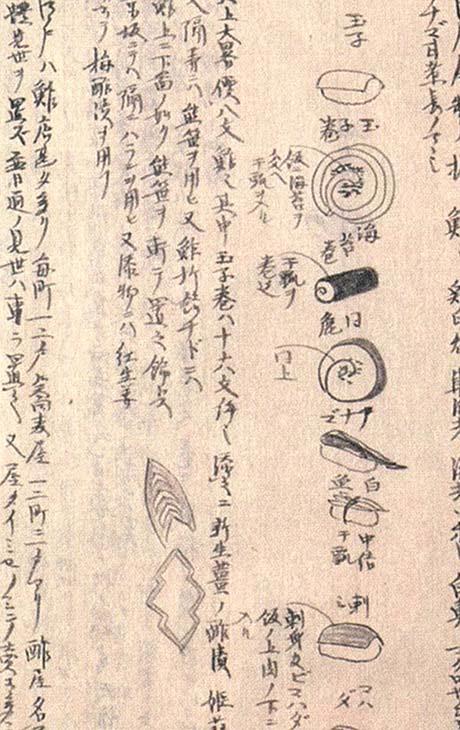
In 1837, Morisada Mankō (Sketches by Morisada) was published. At the top of the image there is omelet sushi. Rolled sushi with omelet can also be seen. Different from now, egg was particularly valued in sushi at the time.
General ingredients for the recipes are omelet, prawn, seasoned prawn, white fish, maguro sashimi, kohada, and boiled sweet anago (conger eel). According to the book, sushi generally costed about 8 mon for a piece, while tamago-maki (rolled omelet sushi) went for double that price: 16 mon. While fish and seafood from Edo Bay was most commonly used, food such as egg, which had a high nutrition valued, also seems to have performed a prominent role in Edo sushi. Before long one or two sushi restaurants appeared, and many sushi sellers set up shops. Food stands also gradually appeared and sushi became a big hit in Edo. The famous restaurants Matsu no Sushi and Yohee-zushi both appear in the book.
The tamago-yaki (Japanese omelet) introduced with pictures in Morisada Mankō is reproduced here. The sushi rice was boiled with small torn nori seaweed and sweetened, after which it was mixed together with small-cut gourds. Omelet was cut in slightly thick sheets, baked and then mixed with the sushi rice. Only from seeing the color of the omelet and smelling its aroma, people in Edo would get hungry. The combination of omelet with mixed rice gave the dish a sweet flavor, which even though simple, was considered satisfying food. Omelet-sushi was considered like gold for the people of Edo, and can be considered one of their favorite treats.
The modern taste of sushi was born in Edo, but developed with the changing demand of the times, evolving into the kind of sushi we eat today. The colorful sushi that adorned springtime feasts, reveal the love and excitement of the people of Edo for sushi, which can still be felt today.
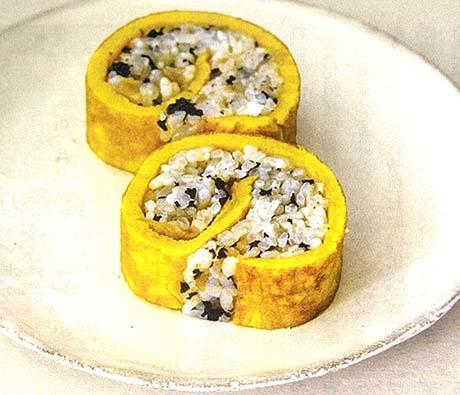
©Akio Takeuchi
Tamagomaki (egg roll sushi)
Ingredients:
Rice with vinegar......proper amount
Nori seaweed......proper amount
Salty-sweet dried shavings of gourd ......proper amount
Eggs......2 eggs
Water......1 large spoon
Sugar......1 small spoon
Salt......a pinch
1 Prepare the rice with vinegar.
2 Tear the nori seaweed to small pieces.
3 Salty-sweet dried shavings of gourd into small pieces.
4 Mix no. 2 and 3 with no. 1
5 Break eggs in a bowl, then add and mix it with water, sugar and salt.
6 Add oil to a tamagoyakinabe (omelet pan), warm it to medium heat and add no. 5. When one side is baked, flip it over and repeat.
7 Put no. 6 on a dish and wrap it around no. 4.
8 Cut no. 7 and arrange it on a plate.

